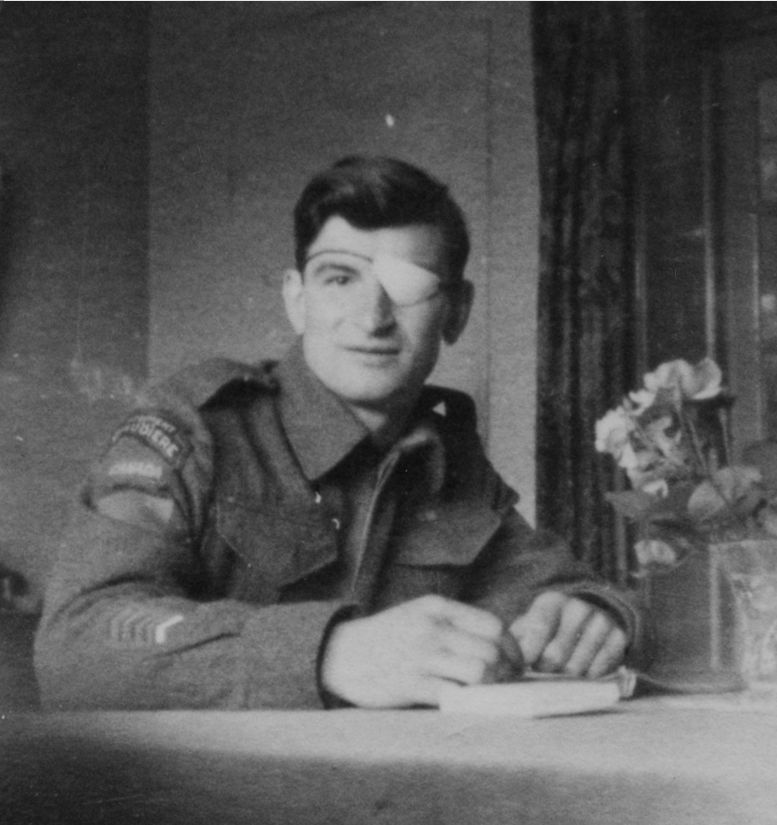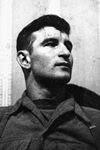I Was There! - How We Breached the Atlantic Wall
The War Illustrated, Volume 10, No. 255, Page 790-793, April 11, 1947.
With grenade and bayonet and tommy-gun Royal Marine Commandos went in from the sea and attacked on D-Day... Here is a close-up of swift-moving battle against Germans entranced behind "impregnable" defences. The vivid recollection is by Major W. R. Sendall, R.M.
The night before D-Day was the longest I have ever known. Our little L.C.I., bearing half the H.Q. of the 4th Commando Brigade, heaved and rolled on her slow progress across the Channel to the intense discomfort of all on board. Dawn of the great day revealed a leaden sky overhanging grey sea whipped into a sullen swell by the wind.
Overhead I heard the roar of hidden bombers, and saw on the skyline a low coast form which, at intervals, church spires needled up through a bank of smoke. The bombardment was in full swing, but we could see little of it. We stooged about in the swell for an interminable time till we saw a long line of little assault craft, bearing The North Shore Regiment of Canada, pitching and tossing as they passed us. Someone waved from one of the packed craft and we waved back. Excitement quickened and the seasickness was forgotten. In the wake of The North Shores our craft turned in towards the distant beach.
I went below to collect my maps, and by the time I returned to the deck the yellow beach of St. Aubin was just ahead – and the sea-wall, festooned with barbed wire. Beyond was a row of villas, one blazing furiously, bright orange of the flames glaring through the black smoke pall. Fully rigged, we lay down on deck, making for the beach at full speed. What happened to the left and right during the following minutes I never knew. As if in blinkers, all I could see was a section of yellow beach, a piece of sea-wall with its barbed wire frieze, red-tiled villas and the bright orange fire rushing towards us.
The craft grounded. Long narrow ramps shot out, and the first men sprang up from the deck to go over. I heard no bullets in the confusion of noise, only the surge and crash of the sea and a sharp crackling that might have been the fire, but the leading man collapsed at the head of the ramp and two or three of his comrades flattened out beside him. I ran forward crouching, but men rose in front of me, pulling the wounded from the head of the ramp. Then over we went, staggering heavy-laden into the waist-deep surge that was heaving great baulks of timber like matchsticks to and fro.
My sodden boots sank into the soft wet sand as I struggled into the shelter of the sea-wall. Both our craft were beached and the men were struggling to get bulky signals equipment down the ramps that were swinging wildly in the waves. We rushed back to hold them steady, and saw mortar bursts appearing in the sea just astern of the craft; and the Naval ratings, firing heavy Oerlikons over our heads, were blasting the enemy in the row of villas. In a few minutes we were all ashore, filing along under the sea-wall to a gap in the minefields and through this on to a road. Pushing forward through a dense blanket of pungent smoke we reached the farmhouse marked down on our maps as a rendezvous.
Shedding my heavier equipment here, I made contact with the H.Q. of 48 Royal Marine Commando, which had landed on our left. The Commando had been exposed to the full fire of the St. Aubin strongpoint, against which the North Shores were still hammering, and had suffered heavily. Many of them had swim ashore considerable distances, though the strong undertow had swept even powerful swimmers away. Nevertheless, the leading troop had already set out down the coast road for the next village, Langrune, which was their objective.
I followed cautiously but saw no sign of the enemy in the shattered streets, though an occasional bullet wailed overhead. I reached the big church in Langrune without incident and, as there seemed to be little resistance, returned to Brigade in St. Aubin, looking in on the way at the Canadians who were still battering at the tough strongpoint, smashing their way through a huge barricade of logs with which the enemy had blocked the narrow street.
It was not until late in the evening that I heard of the sharp check the Commando had encountered when attempting to force their way through the narrow defiles of the mined and barricaded streets to attack the strongpoint on the Langrune seafront. The attack could not be renewed that night, as information came of an expected enemy counter-attack. As we were the only troops between the enemy in Douvres La Delivrande and the crowded beaches, and were very thin on the ground, every available man was ordered into the line.
I spent most of the night scratching for myself a weapon-pit under the church wall on the outskirts of St. Aubin, using an entrenching tool with a rough improvised handle that quickly raised blisters, occasionally straightening my aching back to watch the quick streams of coloured tracer that flamed up from the beaches to beat off enemy sneak raiders coming in low overhead. The anticipated counter-attack never came, and in the morning I went back to Langrune, where the assault on the strongpoint was being renewed.
The only approach to this hedgehog was by way of two narrow streets, both enfiladed by German snipers firing from the roofs of reinforced houses on the front. One of these was hopelessly blocked by mines and wire and swept by machine-gun fire, so that attack had to be directed down the other street. This terminated in a cross-roads in the centre of which was a concrete machine-gun cupola and, beyond, a thick, heavily reinforced concrete anti-tank wall. On the previous day the Marines had penetrated as far as the cross-roads and knocked out the machine-gun, but the wall barred all further progress.
As I came up, the leading troop was clearing the houses up to the cross-roads once more, operating through back gardens where they had some cover from the German riflemen. As I stood in a gap between these houses, beside an officer of the Army Film Unit, one of those riflemen put a bullet through the "bellows" of the camera slung around my companion's neck. We dived into cover with some promptness, and with my rifle I put three bullets through the hole in the roof-top indicated to me as the sniper's hide-out, with what success I never discovered – for an armoured M.10 self-propelled gun, just then moving cautiously down the street, swung round to bear upon the house and demolished it with a couple of 75-mm. shells.
That gun, loaned by the Canadians, was our battering ram. The Marines cleared a path for it by exploding some of the mines, and it sat down near the cross-roads to hammer at point-black range at the wall, huge chips flying off in all directions as each shell smashed into the concrete. Meanwhile, the Germans were dropping a continual rain of mortar shells into the back gardens as our men probed forward. For 90 minutes the S.P. gun battered the wall. By the time its ammunition was exhausted a breach had been made barely practicable for a storming party. A Sherman from the Royal Marine Armoured Support Group then moved up to carry on with the work.
When the upper part of the wall was demolished, the assault troop of the Commando, waiting crouched in the gardens, was ordered in. They dashed across the bullet-swept road to seize possession of the two reinforced houses on each side of the wall. This jump forward was executed in a few minutes and was a first lodgement within the defences. The Marines discovered beyond the wall a deep ditch that prohibited the introduction of a tank, so another troop, armed this time with picks and shovels and high explosive, dashed across to lay charges in the captured houses.
I waited for the explosion, lying flat in the road beside the Sherman. With a roar, half a house went up and a shower of brickbats hurtled down upon us through the thick dust cloud, I pressed myself hard against the ground, trying to squeeze as much of my body as I could under my steel helmet. The Marines then proceeded to shovel the debris from the demolished house into the trench, to form a causeway across which the tank could make its way.
All this while, slowly but surely, the assault troop had been driving the Germans from one house after another, forcing them back on to their seaward defences. When the causeway was complete I nipped out of shelter to signal forward the Sherman that was sitting closed up in the middle of the cross-roads. I had just recovered the shelter of the houses when a bullet from ever-vigilant snipers chipped a piece of brickwork from the corner I had just rounded. The maddening thing about this harassing fire was that we could never see the enemy. They had tunnelled from cellar to cellar of the houses and could pass unseen from one to another, so that by the time we could open fire on one position the German rifleman had moved elsewhere. The first sure sight of a German I had was when they were driven out and surrendered.
The Sherman slowly lumbered forward over the rubble that filled the ditch, to debouch on to the wide promenade of the sea-front. At this point one track slipped into a slit trench, and the armoured monster lurched over at an awkward angle. But it was still possible to bring its Browning machine-gun to bear, and with this it lasted the promenade.
Behind its spray of bullets the Marines went in with a cheer to drive the enemy from his last refuges, the honeycomb of trenches and dug-outs overlooking the beach. With grenade, bayonet and tommy-gun our men went forward; and the Germans had no stomach for such close-quarters stuff with some of the best bayonet fighters in the British forces. They streamed up with their hands above their heads. And so the Marine Commandos made an end to one of the bastions of the Atlantic Wall.
Previous and next article from I Was There!
I Was There! - I Lent a Hand with Mighty Mulberry
In the M.T.C., driving for the Ministry of Supply, Miss Gwen Croft was one of the unknown number of men and women who helped to make possible the great prefabricated harbour that was towed over to Nor
Index
Previous article
No. 460 Squadron
Motto: "Strike and Return" An all-Australian Squadron, No. 460 began training at Breighton, Yorks, in January 1942, equipped with Wellington aircraft. Operational sorties were carried out in the fo





